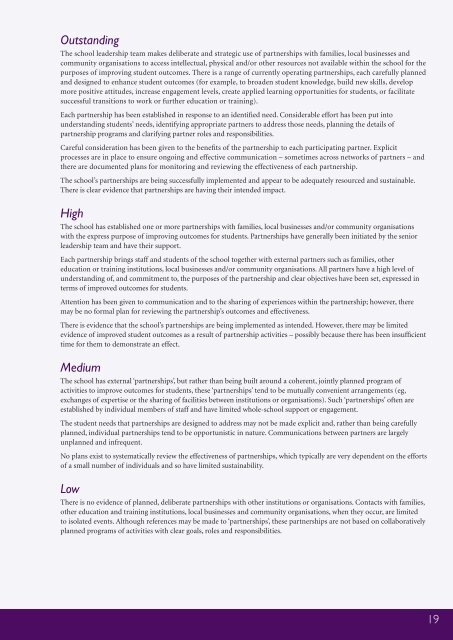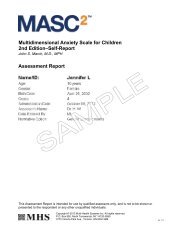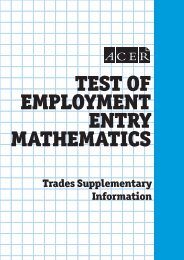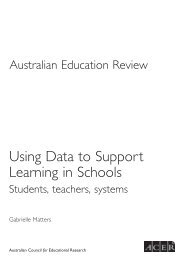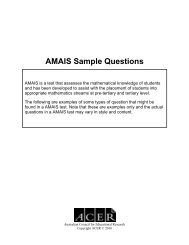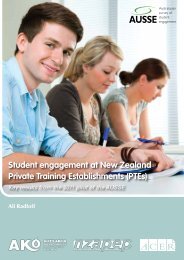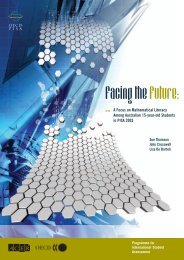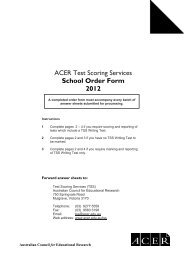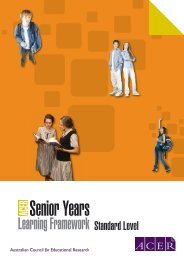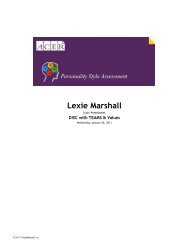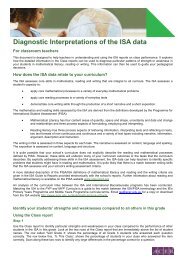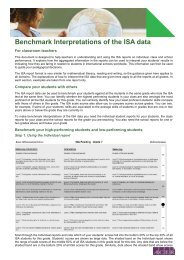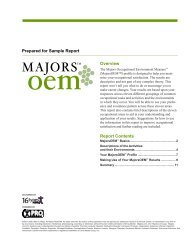National School Improvement Tool - ACER
National School Improvement Tool - ACER
National School Improvement Tool - ACER
Create successful ePaper yourself
Turn your PDF publications into a flip-book with our unique Google optimized e-Paper software.
Outstanding<br />
The school leadership team makes deliberate and strategic use of partnerships with families, local businesses and<br />
community organisations to access intellectual, physical and/or other resources not available within the school for the<br />
purposes of improving student outcomes. There is a range of currently operating partnerships, each carefully planned<br />
and designed to enhance student outcomes (for example, to broaden student knowledge, build new skills, develop<br />
more positive attitudes, increase engagement levels, create applied learning opportunities for students, or facilitate<br />
successful transitions to work or further education or training).<br />
Each partnership has been established in response to an identified need. Considerable effort has been put into<br />
understanding students’ needs, identifying appropriate partners to address those needs, planning the details of<br />
partnership programs and clarifying partner roles and responsibilities.<br />
Careful consideration has been given to the benefits of the partnership to each participating partner. Explicit<br />
processes are in place to ensure ongoing and effective communication – sometimes across networks of partners – and<br />
there are documented plans for monitoring and reviewing the effectiveness of each partnership.<br />
The school’s partnerships are being successfully implemented and appear to be adequately resourced and sustainable.<br />
There is clear evidence that partnerships are having their intended impact.<br />
High<br />
The school has established one or more partnerships with families, local businesses and/or community organisations<br />
with the express purpose of improving outcomes for students. Partnerships have generally been initiated by the senior<br />
leadership team and have their support.<br />
Each partnership brings staff and students of the school together with external partners such as families, other<br />
education or training institutions, local businesses and/or community organisations. All partners have a high level of<br />
understanding of, and commitment to, the purposes of the partnership and clear objectives have been set, expressed in<br />
terms of improved outcomes for students.<br />
Attention has been given to communication and to the sharing of experiences within the partnership; however, there<br />
may be no formal plan for reviewing the partnership’s outcomes and effectiveness.<br />
There is evidence that the school’s partnerships are being implemented as intended. However, there may be limited<br />
evidence of improved student outcomes as a result of partnership activities – possibly because there has been insufficient<br />
time for them to demonstrate an effect.<br />
Medium<br />
The school has external ‘partnerships’, but rather than being built around a coherent, jointly planned program of<br />
activities to improve outcomes for students, these ‘partnerships’ tend to be mutually convenient arrangements (eg,<br />
exchanges of expertise or the sharing of facilities between institutions or organisations). Such ‘partnerships’ often are<br />
established by individual members of staff and have limited whole-school support or engagement.<br />
The student needs that partnerships are designed to address may not be made explicit and, rather than being carefully<br />
planned, individual partnerships tend to be opportunistic in nature. Communications between partners are largely<br />
unplanned and infrequent.<br />
No plans exist to systematically review the effectiveness of partnerships, which typically are very dependent on the efforts<br />
of a small number of individuals and so have limited sustainability.<br />
Low<br />
There is no evidence of planned, deliberate partnerships with other institutions or organisations. Contacts with families,<br />
other education and training institutions, local businesses and community organisations, when they occur, are limited<br />
to isolated events. Although references may be made to ‘partnerships’, these partnerships are not based on collaboratively<br />
planned programs of activities with clear goals, roles and responsibilities.<br />
19


